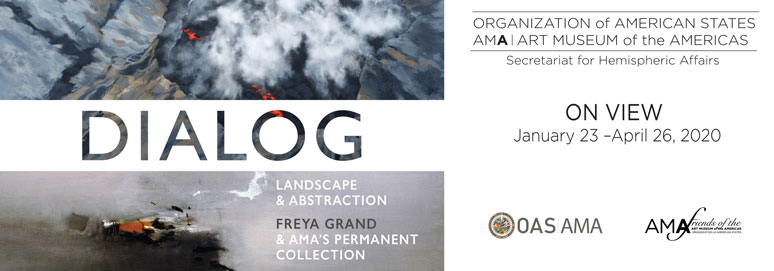The OAS AMA | Art Museum of the Americas presents
DIALOG: Landscape and Abstraction | Freya Grand and AMA’s Permanent Collection
Curated by Adriana Ospina and guest curator Hilary Pierce Hatfield
ORGANIZATION OF AMERICAN STATES
AMA | ART MUSEUM OF THE AMERICAS
DIALOG: Landscape and Abstraction | Freya Grand and AMA’s Permanent Collection
January 23-April 26, 2020
OPENING RECEPTION
Thursday, January 23, 2020
6-8PM
RSVP
PANEL DISCUSSIONS
Women Artists at the Art Museum of the Americas
International Women's Day:
Sunday, March 8, 2020 from 12-1:30pm
RSVP
Earth Day Panel Talk
Art and Our Environment: An Essential Dialog
Thursday, April 23, 2020 from 12-1:30pm
Moderated by Hilary Pierce Hatfield, Exhibition Co-Curator
Panelists include:
Moderated by Hilary Pierce Hatfield, Exhibition Co-Curator
Freya Grand, painter
Dr. Karl Kusserow, Curator of American Art, Princeton University Art Museum
Cletus Springer, Director of The Department of Sustainable Development at OAS and award-winning writer
Paul Villinski, sculptor and environmental activist
Cristina Mittermeier, photographer
RSVP
HOURS
Tuesday-Sunday 10AM-5PM
LOCATION
OAS AMA | Art Museum of the Americas
201 18th Street NW
Washington, DC 20006
ADMISSION
Free
This exhibition pairs important 20th century abstract works by artists in the OAS AMA’s permanent collection with works of contemporary landscape painter Freya Grand. The pairings of Grand and artists living and working in the Americas (1960 – 1973) convey a common dialog through their shared forms, textures, symbols, color, and composition. Here, Grand’s immersive landscapes derived from her experiences in remote regions of Ecuador, Peru, Argentina, Chile, and Costa Rica intermingle with those of such stalwarts of the OAS AMA’s art collection as Maria Luisa Pacheco (Bolivia); Danilo di Prete, Tomie Ohtake, and Manabu Mabe (Brazil); Angel Hurtado (Venezuela); and Anibal Villacis (Ecuador).
The works in this exhibition were selected through a conversation between AMA’s curator Adriana Ospina and guest curator Hilary Piece Hatfield. Hatfield was invited to explore the AMA’s extensive digital archive and in doing so, she noted strong correlations between Freya Grand’s work from the Americas and certain abstract works in the permanent collection. Ospina and Hatfield then visited with Freya Grand at her Washington D.C. studio and continued their curatorial dialog with the artist, reflecting on Grand’s work and Hatfield’s selections from the AMA’s collection. The curatorial team found that the process led them to the selection of many of the same works of art. This resulting exhibition demonstrates a shared language among the artists and suggests that humanity has an essential dialog with the earth.
Grand describes her process as a direct, immersive experience and that she moves fluidly from close proximity to her subjects to observing them from a vast distance. She asserts that, “The two experiences - the one tactile and intimate and physical, the other a privileged bird’s eye view, inform and enrich each other. These experiences allow me to feel the land under my feet, as well as comprehend the larger patterns, structures and forces at play.”
Since 2002, Freya Grand has traversed remote regions of the world. Her works based on her experiences in South and Central America and in the Pacific offer a universal language of form that demonstrate our deep connection to the earth, a relationship that transcends both culture of origin and time. Freya Grand’s body of work includes various biospheres, including Iceland’s glacier fields, the peaks of the Andes, and the vast deserts of Namibia. Grand is deeply committed to painting some of the most powerful and fragile parts of the earth in a manner that distills her subject to its essence. In her formative years as a painter and activist, Grand lived off the grid on the Queen Charlotte Islands in British Columbia. This experience, relying on nature and immersed in nature, help to form her point of view.
It is not only imaginable to see Grand’s landscapes and the abstract works of Pacheco (Bolivia b.1919, United States d.1982) and Mabe (Japan b.1924, Brazil d.1997) as stemming from the same root language, but that these comparisons may be inevitable. The push-and-pull techniques that many artists learned while studying under Hoffman have commonly been applied to portraiture and landscape painting.
The conflicts and resolutions that are manifest in the abstraction of the mid-century, both in the U.S. and in Latin America, are not dissimilar in their shapes, colors, and textures to that of the landscapes that we share. With this exhibition, the AMA seeks to invite a conversation that engages and encourages our deeper connection to the earth and to our fellow inhabitants.
The AMA serves as the principal instrument of cultural diplomacy of the OAS. AMA’s mission is founded on the notion that the arts are transformative for individuals and communities. This guiding principle promotes the core values of the OAS by providing a space for cultural expression, creativity, innovation, dialog, and learning, while highlighting themes such as democracy, development, human rights, justice, freedom of expression, and innovation. AMA’s work draws on contemporary art to showcase a constructive vision of the future of the Americas via local and hemispheric cultural exchange.
Accessibility: This exhibition will be on the museum’s second floor, which is not wheelchair accessible. AMA’s first floor is wheelchair accessible by appointment, with a ramp that can be installed at the back entrance to the museum. There is a flat pathway leading to the back entrance. There is one half-step leading from the first room into the first-floor galleries. There is a flight of winding stairs leading to the museum’s second floor. Restrooms are located on the second floor. For more information on accessibility, or to make an appointment to visit, please contact 202 370 0147 or artmus@oas.org
.


